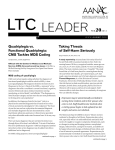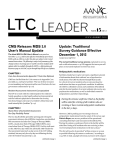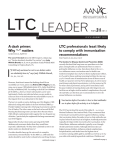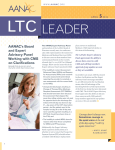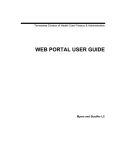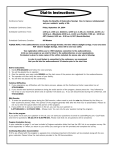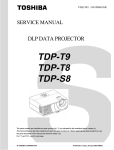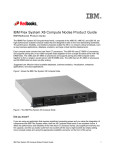Download LTC LEADER
Transcript
LTC LEADER M AY 9 2013 W W W. A A N AC .O R G Current ADL coding policy, RAI Manual revisions highlight CMS keynote MDS correction policy changes to give providers breathing room Caralyn Davis, Staff Writer Caralyn Davis, Staff Writer Highlights from the AANAC 2013 Annual Conference A recent Centers for Medicare and Medicaid Services (CMS) memo to state RAI coordinators explaining a potential clarification to the “Rule of Three” for column 1 (selfperformance) in MDS 3.0 item G0110 (ADL assistance) recently rocked the MDS world because it departed significantly from common interpretations of how to use the ADL selfperformance coding algorithm. (For more information, see “CMS to Tweak ADL Scoring Rule” by Judi Kulus on the AANAC Website or in the April 18 LTC Leader.) Consequently, many participants at the 2013 AANAC Annual Conference were surprised to learn during CMS’ May 4 keynote that the upcoming revisions to the RAI User’s Manual for the MDS 3.0 will not directly address this issue — but that doesn’t mean that coders can ignore the clarification. In the question-and-answer section of the session, Carol Maher, RN-BC, RAC-CT, secretary of the AANAC board of directors and director of education for Hansen, Hunter & Co. PC in Beaverton, Ore., asked CMS officials to comment on how a hypothetical scenario previously submitted by AANAC should be coded. upcoming revisions to the RAI User’s Manual for the MDS 3.0 will not directly address this issue — but that doesn’t mean that coders can ignore the clarification. Specifically, if a resident had one occurrence of limited assistance (code 2), one occurrence of extensive assistance (3), continued on page 2 The upcoming revision to the RAI User’s Manual for the MDS 3.0 will include changes to the MDS correction policy outlined in Chapter 5, “Submission and Correction of the MDS Assessments,” said officials with the Centers for Medicare and Medicaid Services (CMS) during the May 2 Skilled Nursing Facility/Long-term Care Open Door Forum (ODF). These changes will be implemented on May 19. CMS has issued a set of slides, Changes to MDS 3.0 Manual Inactivation/Modification Policy, explaining the changes, and officials also discussed them during the ODF. To implement the MDS correction policy, providers first must be clear about the differences between inactivation and modification, said officials. “There are two primary differences. The first is the effect or impact of the action. While both are used to address errors on an assessment that has been accepted into the QIES ASAP system, a modification will simply replace the assessment being corrected with an active, revised assessment that includes completion of all MDS items and appropriate responses in Section X.” Conversely, an inactivation is used to move a previously accepted assessment into the ASAP database history, said officials. “In the case of inactivation, the record is not replaced as only A0050 and Section X must be completed as part of the inactivation action.” Inactivations are normally used in cases “where the assessment is tied to an event that did not actually occur — therein lies the second primary difference between modification and inactivation,” said officials. “A modification is most appropriately used for typographical or data entry errors, whereas inactivations are used to remove assessments continued on page 5 Current ADL coding policy, RAI Manual revisions highlight CMS keynote, continued from page 1 one occurrence of total dependence (4), and three occurrences of supervision (1) during the look-back period, should that resident be coded as limited assistance — following the apparent instructions on the algorithm — or as supervision as suggested by the recent CMS memo? “At this point, you can’t just follow the algorithm,” stated Ann Spenard, vice president of consulting services for CMS contractor Qualidigm in Rocky Hill, Conn. “In fact, if you read the full 17 pages on coding G0110, you will come to the same conclusion that it would’ve been supervision. You have to understand the Rule of Three and all of the coding guidelines. You cannot use the algorithm in and of itself without reading all the caveats, all of the boxes.” According to the Rule of Three, “once you have a level that is provided three or more times, you code that level,” explained Spenard. “You wouldn’t even go into the combining of anything. Let’s say in that example, you had five times limited and four times supervision. You would code to the more dependent. It is a matter of applying the rules in the proper order. So you’re not going to the combination rule until you don’t have the care provided at a particular level three or more times.” and simpler for people to code,” noted Pratt. “We will be reaching out to our stakeholders. We’re very much interested in getting feedback. We want to clarify our policy.” CMS contractors are working to potentially develop a stand-alone coding algorithm, pointed out Spenard. However, at the present time, MDS assessors cannot base their coding on the algorithm alone. “You have to read those 17 pages. Look at the examples, read [the instructions], and understand that it is all of that information together that then gives you how you should code Section G,” she added. Here are some highlights of what CMS has clarified in the new RAI Manual revisions, which are slated for release on May 9: PPS schedule for residents transitioning from MA plans On page 2-45, CMS finally explained how to handle the Medicare prospective payment system (PPS) schedule for residents who transition from Medicare Advantage to traditional fee-for-service Medicare Part A, said Spenard. The new instruction states: “If a resident goes from Medicare Advantage to Medicare “There isn’t going to be a change in the policy, but we hope that we can break it down in a way that is easier to digest and simpler for people to code,” noted Pratt. “We will be reaching out to our stakeholders. We’re very much interested in getting feedback. We want to clarify our policy.” This interpretation is in fact current policy that should be followed now, said Spenard. “There is no policy change. It has always been this way.” Further, CMS has no plans to change this existing policy, said Mary Pratt, director of the Division of Chronic and Postacute Care Responsibilities at CMS. (Pratt and other CMS central office staff participated by telephone due to sequestration.) “There isn’t going to be a change in the policy, but we hope that we can break it down in a way that is easier to digest 2 AANAC.org | 800.768.1880 Part A, the Medicare PPS schedule must start over with a 5-day PPS assessment, as the resident is now beginning a Medicare Part A stay.” Item A0800 (gender) This clarification removes the dash (-) as a valid value for the item set, said Spenard. “So we have to determine whether [the resident is] male or female, and the gender on the MDS must match the gender in the Social Security system.” Some residents might dress and identify themselves differently than they are identified in the Social Security system, said Spenard. For example, a resident might want to be recognized as female when he is actually male according to Social Security. “So that might be a little bit of a difficult item for some people, and you might have to do due diligence to research that,” she said. Once implemented on May 19, “this change applies to all records regardless of the target date,” said Spenard. “Under no circumstances can you dash. If you attempt to break the rules and put a dash, the record will not successfully be submitted, and a fatal error message will appear on the facility’s final validation report.” There is one caveat, she noted. Although A0800 cannot be coded with a dash, when completing Section X for the Modification or Inactivation process, if the original record had a dash response, then X0300 (gender) also will require a dash in order to locate the original record in the database. “It needs to match exactly. Otherwise the system can’t find it,” she explained. Item G0110 The clarifications that CMS will make to this item primarily involve aligning the instructions on the item set with the manual text and the coding algorithm language, said Spenard. For example, the last bullet under the third Rule of Three has new “and/or language” to match the item set, she related. The edited manual text states: “When there are three or more episodes of a combination of full staff performance, weight-bearing assistance, and/or non-weight bearing assistance — code limited assistance (2).” Item I5100 (quadriplegia) As expected from the last two Skilled Nursing Facility/Long-term Care Open Door Forums, CMS has updated the coding instructions for quadriplegia. These clarifications don’t address continued on page 3 A A N AC LT C L E A D E R 0 5 . 0 9 . 2 013 © 2013 AANAC. No part of this publication may be reproduced without written permission from AANAC. The information presented is informative and does not constitute direct legal or regulatory advice. Current ADL coding policy, RAI Manual revisions highlight CMS keynote, continued from page 2 whether or not there is a difference in terms of function and amount of care received for quadriplegia related to spinal cord injury vs. any other type of quadriplegia, noted Spenard. Rather, the clarifications focus on “the intent of the definition of this particular item,” which is not to capture functional quadriplegia but to capture a physician-documented diagnosis of quadriplegia, she stressed. “Quadriplegia should only be coded if there is a physician-documented diagnosis of quadriplegia related to spinal cord injury in the medical record,” said Spenard. Several conditions can cause a functional immobility similar to quadriplegia, including cerebral palsy, severe rheumatoid arthritis, end-stage Alzheimer’s disease, or cerebrovascular accident (CVA). “But do not code I5100 to reflect functional status or symptoms associated with these or other debilitating diseases,” she said. Section L (oral/dental status) Under the coding tips on page L-3, CMS has added this language: “Mouth or facial pain coded for this item should also be coded in Section J, items J0100 through J0850, in any items in which the coding requirements of Section J are met.” Those Section J items are interview questions, and they have a different time frame for the look-back period (i.e., five days vs. seven days for Section L), noted Spenard. “So it’s not an automatic. But the idea is that if [the resident has] mouth pain, you want to make sure that, if it is relevant and falls in the same time period, you consider coding the pain in Section J also.” Section M (skin conditions) In addition to making some language consistency edits, CMS has added new information due to recent National Pressure Ulcer Advisory Panel updates, said Spenard. Some of the key changes are discussed below. However, “I strongly encourage you to read the manual around Section M and see all of the changes that have been put in place,” she recommended. there would need to be an increase in numerical stage in order for it to be considered as worsened.” Item M0210 (unhealed pressure ulcers) For example, if two pressure ulcers separated by a bridge of skin were Stage 3 and now that skin is gone and the wound is a Stage 4, “in that situation you would code it as worsened,” explained Spenard. “But if it stayed as a Stage 3, we wouldn’t say it was worsened just because now we are measuring it as one wound.” Under the coding tips on page M-5, CMS has added this guidance: “Oral mucosal ulcers caused by pressure should not be coded in Section M. These ulcers are captured in item L0200C, Abnormal mouth tissue. Mucosal ulcers are not staged using the skin pressure ulcer staging system because anatomical tissue comparisons cannot be made.” Item M0300D (Stage 4 pressure ulcers) Under the coding tips on page M-15: CMS has added a clarification about cartilage: “Cartilage serves the same anatomical function as bone. Therefore, pressure ulcers that have exposed cartilage should be classified as a Stage 4.” Pressure ulcers with exposed cartilage are most commonly seen on the ears, noted Spenard. Item M0800 (worsening in pressure ulcer status since prior assessment (OBRA or scheduled PPS) or last admission/entry or re-entry) Under the coding tips on page M-26, CMS has added: “If a pressure ulcer was numerically staged and becomes unstageable due to slough or eschar, do not consider this pressure ulcer as worsened. The only way to determine if this pressure ulcer has worsened is to remove enough slough or eschar so that the wound bed becomes visible. Once enough of the wound bed can be visualized and/or palpated such that the tissues can be identified and the wound restaged, the determination of worsening can be made.” CMS has added this coding tip as well: “If two pressure ulcers merge, do not code as worsened. Although two merged pressure ulcers might increase the overall surface area of the ulcer, M0900 (healed pressure ulcers) On page M-29 under the Planning for Care section of the item rationale, CMS has revised the guidance to state: “Clinical standards do not support reverse staging or back staging as a way to document healing as it does not accurately characterize what is physiologically occurring as the ulcer heals. For example, over time, even though a Stage 4 pressure ulcer has been healing and contracting such that it is less deep, wide, and long, the tissues that were lost (muscle, fat, dermis) will never be replaced with the same type of tissue ... Nursing homes can document the healing of pressure ulcers using descriptive characteristics of the wound (i.e., depth, width, presence or absence of granulation tissue, etc.) or by using a validated pressure ulcer healing tool. Once a pressure ulcer has healed, it is documented as a healed pressure ulcer at its highest numerical stage – in this example, a healed Stage 4 pressure ulcer.” M1040E (surgical wounds) On pages M-34 and M-35 CMS has updated the coding tips to clarify surgically debrided pressure ulcers vs. surgical wounds as follows: •“Surgical debridement of a pressure ulcer does not create a surgical wound. Surgical debridement is used to remove necrotic or infected tissue from the pressure ulcer in order to facilitate healing. A pressure ulcer that has been surgically debrided should continue to be coded as a pressure ulcer.” continued on page 4 3 AANAC.org | 800.768.1880 A A N AC LT C L E A D E R 0 5 . 0 9 . 2 013 © 2013 AANAC. No part of this publication may be reproduced without written permission from AANAC. The information presented is informative and does not constitute direct legal or regulatory advice. Current ADL coding policy, RAI Manual revisions highlight CMS keynote, continued from page 3 •“Do code pressure ulcers that require intervention for closure with grafts and/or flap procedures in this item (e.g. excision of pressure ulcer with myocutaneous flap). Once a pressure ulcer is excised and a graft and/ or flap is applied, it is no longer considered a pressure ulcer, but a surgical wound.” M1040H (Moisture Associated Skin Damage) “We certainly see this a lot in nursing homes,” said Spenard. Consequently, CMS has edited the bullet to state: “Moisture associated skin damage (MASD) is a result of skin damage caused by moisture rather than pressure. It is caused by sustained exposure to moisture which can be caused, for example, by incontinence, wound exudate and perspiration. It is characterized by inflammation of the skin, and occurs with or without skin erosion and/or infection. MASD is also referred to as incontinenceassociated dermatitis and can cause other conditions such as intertriginous dermatitis, periwound moistureassociated dermatitis, and peristomal “CARE is not a tool,” she stressed. “CARE is a set of standardized items [that] are being substituted into the existing tools. It’s about standardizing the information, not about changing your processes.” moisture-associated dermatitis. Provision of optimal skin care and early identification and treatment of minor cases of MASD can help avoid progression and skin breakdown.” The key for providers is to “make sure you know what you’re looking at,” says Spenard. On facility site visits, “it is not uncommon” to see residents with a fungal infection or MASD who are 4 AANAC.org | 800.768.1880 being coded as having pressure ulcers, she pointed out. “We want to capture a pressure ulcer when it is a pressure ulcer, but we want to make sure that we are not capturing something as a pressure ulcer when it isn’t one.” M1200F (surgical wound care) Consistent with the clarification for M1040E, CMS has edited the guidance for this item to state: “Surgical debridement of a pressure ulcer does not create a surgical wound. Surgical debridement is used to remove necrotic or infected tissue from the pressure ulcer in order to facilitate healing, and thus, any wound care associated with pressure ulcer debridement would be coded in M1200E, Pressure Ulcer Care. The only time a surgical wound would be created is if the pressure ulcer itself was excised and a flap and/or graft used to close the pressure ulcer.” The CMS keynote also highlighted the agency’s efforts to ensure quality of care and to standardize assessment across settings and tools. Jennifer Pettis, RN, BS, WCC, a CMS consultant, revealed that the nation’s nursing homes did not meet the Partnership to Improve Dementia Care’s national goal of achieving a 15% reduction in the national prevalence rate of antipsychotic medication use in longstay nursing home residents by year-end 2012. The Partnership achieved a 6.45% reduction, meaning about 28,500 fewer residents received antipsychotics. •When medication is prescribed by a covering practitioner in an urgent situation is it re-evaluated by the primary care team and discontinued when possible? •Are other psychopharmacologicals prescribed if/when antipsychotic medications are discontinued or reduced? •Is staff education provided related to dementia and how is the success of the education measured? •How is the Quality Assessment and Assurance (QAA) committee providing oversight of dementia care? Barbara Gage, PhD, fellow and managing director of the Center for Health Care Reform at The Brookings Institution discussed Continuity Assessment Record and Evaluation (CARE) item development. CARE, which was developed through the Post Acute Care Payment Reform Demonstration, is “an effort to standardize assessment items across all of the different CMSrequired assessment tools,” noted Gage. “CARE is not a tool,” she stressed. “CARE is a set of standardized items [that] are being substituted into the existing tools. It’s about standardizing the information, not about changing your processes.” ● With new dementia care guidance likely arriving in June, nurse executives should review their facility processes and practices and ask the following questions, she advised: •Is input from nursing assistants, nurses, social workers, therapists, family and other caregivers working closely with the resident obtained routinely? How about input from all three shifts and weekend caregivers? •How is communication between shifts and between nurses and practitioners or prescribers? A A N AC LT C L E A D E R 0 5 . 0 9 . 2 013 © 2013 AANAC. No part of this publication may be reproduced without written permission from AANAC. The information presented is informative and does not constitute direct legal or regulatory advice. MDS correction policy changes to give providers breathing room, continued from page 1 that relate to an event that did not occur which is a significant error on the assessment.” Inactivations should be used in cases where a significant error is discovered on the assessment. According to current policy, inactivation is required if an error is discovered in the following items: •A0200 (type of provider); •A0310 (type of assessment); •A1600 (entry date) — on entry tracking record, A0310F = 1; •A2000: (discharge date) — on discharge/death-in-facility record, A0310F = 10 – 12; and •A2300 (assessment reference date: ARD). A modification, on the other hand, is used to address errors “identified in the clinical items throughout the MDS,” noted officials. Effective May 19, providers will be able to modify assessments “in a number of new situations,” said officials. “A modification will now be permitted to be used for situations where a typographical error is discovered in any of the A0310 items that are used to determine the type of assessment so long as the item set code [ISC] connected with the erroneous assessment does not change.” A0310: Modify or inactivate? To determine when a modification is — and is not — appropriate for item A0310, a facility should ask: Will addressing the error discovered in A0310 cause the item set to change? “If yes, then inactivate the erroneous assessment,” said officials. “If not, then modification is permitted, assuming there are no other errors that prevent modification.” CMS offered two examples: Example 1: An MDS is coded as a combined 30-day scheduled PPS assessment and a changeof-therapy Other Medicare Required Assessment (COT OMRA): •A0310A = 99; None of the above •A0310B = 03; 30-day scheduled assessment •A0310C = 04; COT OMRA The assessment should have been coded as a standalone 30-day assessment. Can this error be corrected through modification? “The answer is yes,” said officials. “The reason this answer is yes is that the item set used to code the assessment, regardless of if it is connected with a COT OMRA, is the item set for the 30-day assessment. Since the ISC did not change and the same items would be used in either case, this error can be corrected through modification.” Example 2: An MDS is coded as a standalone COT OMRA: •A0310A = 99; None of the above •A0310B = 07; Unscheduled assessment used for PPS •A0310C = 04; COT OMRA RAI Manual includes a handy chart on page 2-77 titled “Nursing Home Item Set Code (ISC) Reference Table.” This table should help providers determine “whether or not the ISC is going to change subsequent to the modification,” said officials. A modification also will be allowed for the entry date on an entry tracking record. “Modifications were permitted on the entry date on the other assessment types in the past,” noted officials. “So this revision will allow modifications of the entry date on basically all assessment types, now including the entry tracking record. The same goes for the discharge date, where a modification may be used for errors in the discharge date on a discharge or death-in-facility record.” What’s an ARD typo? Finally, typographical errors in the ARD also may be corrected through modification. “In other words, if correcting the ARD would result in a different look-back period than that which was used by the facility staff to “A modification will now be permitted to be used for situations where a typographical error is discovered in any of the A0310 items that are used to determine the type of assessment...” The assessment should have been coded as a combined 30-day PPS MDS and COT OMRA (i.e., the reverse of example 1). Can this error be corrected using modification? “The answer in this case is no,” said officials. “The reason the answer is no is that the item set used to code the assessment would be different between the erroneous assessment and the revised assessment. As such, the ISC would not be the same, and modification would not be permitted in this case. If this type of error was discovered, the facility would need to inactivate the assessment and proceed accordingly.” Section 2.15, Determining the Item Set for an MDS Record, in Chapter 2 of the code the responses on the assessment with the erroneous ARD, then this is not a typographical error, and the assessment should be corrected using the inactivation process,” said officials. Here’s an example: An MDS was completed for Ms. Jones. Based on the ARD, the therapy staff tallied Mrs. Jones’ as receiving 640 therapy minutes during the look-back period. However, when informed of the error in the ARD, the therapy staff then says that Ms. Jones should have been tallied to 680 minutes. “This would not be an example of a typographical error in the ARD used to code the assessment,” stressed officials. continued on page 6 5 AANAC.org | 800.768.1880 A A N AC LT C L E A D E R 0 5 . 0 9 . 2 013 © 2013 AANAC. No part of this publication may be reproduced without written permission from AANAC. The information presented is informative and does not constitute direct legal or regulatory advice. MDS correction policy changes to give providers breathing room, continued from page 5 “It would represent a substantive change in the ARD that would require inactivation of the assessment with the erroneous ARD.” In addition to these new opportunities for modification, modification also is still permitted in cases where errors are discovered in one or more clinical items, •Warning error message 1061. This error message will indicate “there was a change in the target date and/or the reason for assessment and a change to one or more clinical items on the assessment,” said officials. •Warning error message 1062. This error message will indicate that While the changes to the MDS correction policy will be implemented on May 19, that doesn’t mean that errors that occurred prior to May 19 cannot be modified in accordance with the new policy. said officials. Inactivation requests are still necessary in certain situations, specifically: •For an error in item A0200 (provider type); or •For a non-typographical error in the A0310 items used to determine the assessment type when correcting the error would change the item set used to code the assessment; or •For a non-typographical error in A2300 (ARD) that results in a different lookback period. These correction policy changes could generate new error messages on facility validation reports: 6 AANAC.org | 800.768.1880 “changes occur that would prompt message 1061, but that there is also a change in the Medicare RUG value resulting from the modified items,” said officials. The two warning error messages will help providers “identify cases where perhaps modification was not the appropriate process to be used to address the errors identified,” they suggested. •Fatal error message 3839. This error message will indicate that “the modification that the facility is attempting to do will change the ISC,” said officials. “As discussed previously, this is not permitted, and the modification will simply not be accepted.” Different records in a submission file could receive different errors, but a single record would only receive one or none of the above error messages, said officials. For example, “you would not see error message 1061 and 1062 for the same assessment.” While the changes to the MDS correction policy will be implemented on May 19, that doesn’t mean that errors that occurred prior to May 19 cannot be modified in accordance with the new policy. The key is the date the error is discovered — not the date the error was made. “The RAI Manual states very clearly that errors identified are to be corrected within 14 days of that discovery,” said officials. “It is the date of discovery that starts that clock, and then 14 days from that date that would end clock. Anything that is discovered within that 14-day period is still permissible.” For example, if a facility discovered an error on May 2, that error would have to be corrected within 14 days (i.e., prior to May 19 and thus ineligible for the new policy). However, if that same error was discovered on May 20, “then that would begin the clock as far as when the error would need to be corrected by,” and the error would be eligible for the new policy if applicable, said officials. ● A A N AC LT C L E A D E R 0 5 . 0 9 . 2 013 © 2013 AANAC. No part of this publication may be reproduced without written permission from AANAC. The information presented is informative and does not constitute direct legal or regulatory advice. AANAC Board of Directors Ruth Minnema rn, ma, c-ne, rac-ct Chair Peter Arbuthnot aa, ba, rac- ct Vice Chair Carol Maher rn-bc, rac- ct Secretary Patrice Macken mba, rhia, lnha, rac- ct Treasurer Susan Duong rn, bsn, nha, rac- ct, c-ne Gail Harris rn, bsn, rac- ct, c-ne Joanne Powell nha, rhia Carol Siem msn, rn, bc, gnp, rac- ct Diana Sturdevant ms, gcns-bc AANAC Expert Panel AANAC is pleased to introduce you to our panel of volunteer reviewers who represent the best and the brightest in our field: How do I capture “while not a resident” if the ARD is set on day 7? For the capture of the items for ‘while not a resident’ I am confused with the coding instructions. If the ARD minus the entry date is 7 or greater you do not code this section. However, this is treating the first day of stay as day ‘0’ not day ‘1’. For example, if entry date is 2.1.13 and I set my ARD for day 7 (2.7.13) the calculation for K0510 requires an answer even though the patient was admitted to the facility for the 7 days. Any comments? Betty Frandsen rn, nha, mha, c-ne Nichols, NY Carol responded: Treatment could have occurred earlier in the day of admission while the resident was still in the hospital. Robin L. Hillier cpa, stna, lnha, rac-mt President, RLH Consulting Carol Maher, RN-BC, RAC-MT ([email protected]) Becky LaBarge rn, rac-mt Vice President, Clinical Reimbursement The Tutera Group Deb Myhre rn, c-ne, rac-mt Nurse Consultant, Continuum Health Care Services Ron Orth rn, nha, rac-mt Clinical Reimbursement Solutions, LLC, Milwaukee, WI Andrea Otis-Higgins rn, mlnha , cdona , clnc, rac-mt CEO, Administrator, St. Andre Healthcare Biddeford, ME Rena R. Shephard mha, rn, rac-mt, c-ne AANAC Executive Editor President, RRS Healthcare, Consulting Services, San Diego, CA Judy Wilhide Brandt rn, rac-mt, c-ne Regional MDS/Medicare Consultant President, Judy Wilhide MDS Consulting, Inc. All the articles in this LTC Leader can also be found on the AANAC.org website. 7 Q+A AANAC.org | 800.768.1880 Scenario resulting in the 14-day not used for payment. • Patient admitted 4/16/13 and the 5-day ARD was set on 4/23/13 with a RUG of RMB10. • The 14-day ARD was set on 4/28/13 but the patient only received 4 days of therapy (4/22/13 through 4/28/13), which dropped the RUG to PD120 • The COT ARD was set for 5/5/13 with a RUG of RMB0D. Are my ARD’s and assessment types correct set correctly? How should the days be billed? Would the 5-day be billed for 9 days, the 14-day for 4 days and the COT for 16 days? Ronald responded: The billing would be as follows: • The selected assessment types and the ARD are appropriate • The 5-day would pay for days 1 -13 • The COT would begin paying on day 14 until the next assessment is in effect, most likely the 30-day. • The 14-day would not be used for payment. Ronald A Orth, RN, NHA, CPC, RAC-MT ([email protected]) Does an Emergency Room visit break the wellness count? To qualify for a 60 day spell of wellness, does going to the Emergency Room break this wellness period? Rena responded: No, but an inpatient hospital admission would if it occurred during the countdown to the total 60 days. Rena R. Shephard, MHA, RN, RAC-MT, C-NE ([email protected]) How can I get incontinent residents off my QM reports? We have residents who trigger (they meet the criteria), are not full staff performance for any ADLs, do not have advanced cognitive issues, and are on a toileting program, and still trigger for low risk bladder loss. How do we get these residents off, or will they always trigger? I do not see a toileting program as an exclusion, so I am presuming they stay on? Lisa responded: As long as a resident is coded frequently or always incontinent (2 or 3) and not high risk (totally dependent for self-performance in bed mobility, transfers, loco on unit and severely impaired cognition), he/she will continue to trigger the low risk QM. Lisa Hohlbein, RN, RAC-MT, RAC-CT ([email protected]) A A N AC LT C L E A D E R 0 5 . 0 9 . 2 013 © 2013 AANAC. No part of this publication may be reproduced without written permission from AANAC. The information presented is informative and does not constitute direct legal or regulatory advice.







